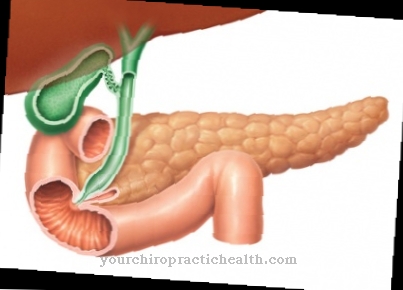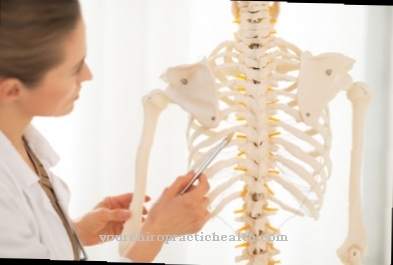A person's movement is influenced by various psychological processes such as concentration or emotionality. This causal interplay is called Psychomotor designated.
What is psychomotricity?

There are different Psychomotor schoolsthat emphasize the interplay of psychological experience and the development of perception and motor skills. The individual schools represent different assumptions as to how impaired movement sequences can arise. These concepts have different focuses and are also summarized under the terms mototherapy, motopedics, motopedagogics, movement therapy or movement education.
The basic assumption of psychomotor skills is that the development of personality must always be understood holistically. This means that physical and psychological areas are connected with each other and movement experiences must always be understood as personal experiences. For example, a person's posture always says something about their mental state. This also applies to children: Movements not only influence their motor skills, but also affect the perception of their own abilities. Especially in children, rational, emotional and mental processes are very closely linked. Emotions are also expressed through movement, which means that movement games, for example, make contact with children much easier.
The term "psychomotor" therefore includes the unity of motor and psychological processes, the term "psychomotor" describes the promotion of development with the help of movement, which is becoming more and more widespread today. Ernst Kiphard is considered to be the forefather of psychomotor skills, whose sports offer for aggressive and behavioral children had a positive effect on their emotional development. According to Kiphard, motor abnormalities in children with behavioral problems are due to minimal cerebral dysfunction.
This results in deficits in the area of movement or perception and, as a result, hyperactivity, motor restlessness, concentration disorders or inhibited behavior. However, according to Kiphard, through motor activity it is possible to stabilize and harmonize the personality of the children and adolescents. For example, Kiphard used the trampoline to train coordination and movement.
Function, effect & goals
However, Kiphard's concept was considered too deficit-oriented and was ultimately developed further, with the child's point of view coming to the fore. New approaches emerged such as the child-centered approach according to Meinhart Volkamer and Renate Zimmer. This is similar to play therapy according to Virginia Axline and is intended to offer the children a space for social experience and movement so that they learn to express and cope with their problems through movement.
The movement experiences are only slightly controlled and aim to strengthen the children's self-concept. The competence-based approach is of the opinion that children who suffer from movement disorders also develop psychological problems which are intended to compensate for the lack of movement behavior. The competence-oriented approach understands aggressiveness, for example, as an expression of a problem in the motor area. In this context, psychomotor skills can help to develop movement skills afterwards. Jürgen Seewald, on the other hand, is a representative of the understanding approach of psychomotor skills. He developed so-called relationship or body issues for the children, with the help of which the cause of the problems can be identified. In a psychomotor setting, these difficulties can then be subsequently processed and overcome.
Marion Esser represents an approach that is oriented towards depth psychology. For them, movement is also an inner movement, with Gestalt psychology, developmental psychology and psychoanalysis being the theoretical foundations. Systemic psychomotor skills understand psychomotor development as an adaptation to the respective social environment. Accordingly, interpersonal relationships must also be checked and treated in children who suffer from motor abnormalities. The various approaches to psychomotor skills are mainly used in child and adolescent psychiatry, whereby the use of the respective psychomotor school depends on the performing psychomotor. The aim is as holistic an approach as possible in order to be able to offer the children and young people assistance on a relatively broad level. Psychomotor therapies are often paid for by health insurance companies.
They are mainly carried out in psychomotor practices, but elements of this can also be found in the work of speech therapists, occupational therapists or physiotherapists. There are also offers in kindergartens and in the field of school sports, but psychomotor skills are also used in special and curative education, where children and young people with physical, mental or emotional disabilities are cared for. These often have problems in the area of cognition, communication, emotion, motor skills or sensory skills, whereby these areas can be influenced extremely positively with psychomotor measures.
In the meantime there are also many research results that show how important perception and movement are for early childhood development, especially in the areas of cognition, social behavior, language development and emotionality. In psychomotor skills, for example, devices such as roller boards, balancing gyroscopes or pedalos are used. These address the balance and are very suitable for promoting children with developmental problems. The way in which the devices are discovered by the children is very important. Important contents of psychomotor skills are:
- Self and body experiences such as physical expression or sensory experiences
- Material experiences and learning about movement
- Social experiences such as communication with the help of movement
- Rules games with rules that are tailored to a specific situation.
You can find your medication here
➔ Medicines against concentration disordersRisks, side effects & dangers
A Psychomotor therapy poses no dangers, but aims to encourage children as early as possible in order to reduce the risk of possible impairments or disturbances. The child's skills are to be strengthened and risk factors minimized.
























.jpg)



